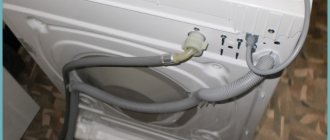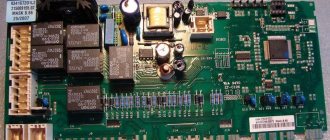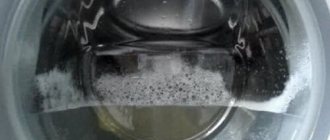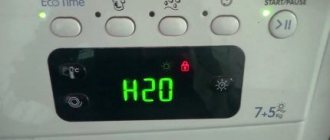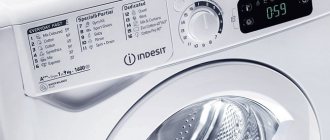The washing machine does not heat the water when washing. This problem occurs quite often, and there are many reasons why the water does not heat up. It is very important to eliminate this problem, because washing different types of laundry requires a certain temperature.
Every housewife knows that in order to achieve the best washing result, you should select the desired temperature mode. For this purpose, there is a special tag on things, which indicates a point or digital value of the recommended temperature. If woolen items are washed in cold water, then bed linen or towels are washed in water heated to a certain temperature. But what to do if the washing machine does not heat the water? This article will describe and analyze the main causes of this malfunction, as well as ways to solve them.
How to check if a washing machine is heating water
A situation may occur when the washing unit has fully completed all stages of washing, but the laundry was poorly washed, although the same detergent was used. One of the reasons may be non-compliance with the temperature regime. In other words, the machine washed clothes in cold water. In this case, it is worth checking whether the water entering the washing drum is heating up.
To do this, you need to select one of the washing modes, which involves heating the water to a temperature of 50-60*C and 20 - 30 minutes after it starts, touch the glass of the loading hatch. For top-loading machines, place your palm on the top cover. If these elements are warm, the water heats up; if they are cold, the washing unit is faulty. After finishing washing, you should identify the causes of the malfunction and eliminate the malfunction. Further use of the washing machine will not only not lead to the desired washing result, but may also render it completely unusable.
Call the master: where to find, how to avoid falling for scammers?
If independent repairs do not lead to a positive result and the Samsung washing machine still does not start heating water, then professionals will come to the rescue.
There are several ways to select and call a technician . The first and easiest is to look for information on the Internet. There are a sufficient number of service center websites, as well as private advertisements on forums, after studying which you can choose the right specialist.
If for some reason there is no access to the Internet, you can call a repairman to your home using an advertisement in the newspaper or by finding out the coordinates from friends.
In order for the washing machine repair to be completed successfully, when calling a technician to your home, you should pay attention to the following points:
- a professional will listen carefully, ask questions about the brand of the washing machine, the type of breakdown, the year of manufacture of the household appliance (fraudsters are not interested in this information);
- an honest master will never take an advance payment without even assessing the volume of work;
- A decent specialist is always in touch and answers all questions.
If the repair is carried out by a service center specialist, upon completion of the work he must draw up a corresponding report (in two copies), which is signed by both parties.
Replacing a heating element will cost an average of 1,000 rubles, replacing a thermostat - from 1,300 rubles. Only a specialist can announce the exact cost of the work after a complete diagnosis of the breakdown.
The final amount may be affected by:
- complexity and urgency of the work,
- cost of new spare parts (prices vary depending on the model and manufacturer).
Everything about repairing Samsung washing machines is in this section of the site.
Reasons why the washing machine does not heat the water
A washing unit is a complex household device consisting of many elements. The reason for the lack of water heating may be a malfunction or breakdown of:
- heating element (heating element);
- water heating sensor (thermostat);
- programmer (electronic unit);
- water level sensor in the tank (pressostat).
Also, the water may not heat up enough when:
- incorrect connection of the washing unit to the drainage system, resulting in self-draining of heated water caused by the siphon effect;
- incorrect choice of washing program, in which the selected mode in favor of a higher temperature mode is ignored.
There are many reasons why the machine does not heat the water, so in order to find out the source of the malfunction, you need to follow the principle “from simple to complex.”
Checking the heating temperature
As you know, for high-quality washing, the correct choice of program and the required liquid temperature are important. Modern machines have the function of heating liquid up to 95 degrees (which completely replaces boiling). How can you tell if the machine is heating up or not? Here are some recommendations from experts on how to determine the heating temperature yourself:
- laundry is washed poorly;
- during operation, the window of the machine is always cold;
- an unpleasant smell of mustiness or staleness after finishing work.
Identifying the faulty element
If periodic self-draining of warm or hot water occurs (can be monitored by heating the drain hose), it is necessary to eliminate the siphon effect and correctly connect the washing unit to the drain system. The problem is successfully solved by installing a check valve in the system.
If the washing machine does not heat the water at all, you should remove the back or side covers and check the connection of the heating element terminals (TENA) with the current-carrying wires.
When washing, especially in spin modes, all elements of the washing unit are subject to vibration loads, which can lead to separation of the elements. By reconnecting the disconnected wire, you can eliminate the problem.
Washing units from Samsung, LG, Ariston, Candy, Bosch and other well-known brands have a similar structure and connection of heating elements. As a rule, a tubular heating element is used, which converts electrical energy into thermal energy by creating electrical resistance.
Adviсe
- If your washing machine has been in use for more than 7 years, most likely most of the problems in its operation are related to the heating element. The quality of our tap water leaves much to be desired, so the service life of the heating element is noticeably reduced. Experts advise replacing this element as soon as the first problems appear.
- Modern models of washing machines are equipped with a forced water heating function (read how to start it in your user manual). If the thermostat malfunctions, this function will help you do without replacing the water temperature sensor for some time.
- One of the indicators that the washing machine is not heating the water is the musty smell of the washed items. It does not always appear, but if you notice it, first of all you need to test the heating element for serviceability.
- In order to extend the service life of the tubular heating element (after all, interruptions in water heating are most often associated with it), you need to use only high-quality washing powders and not exceed the dosage of detergents and care products. If you are concerned about the quality of your tap water, install a flow-through filter to reduce the hardness level.
Sources
https://vannayasovety.ru/tekhnika/stiralnaya-mashina-ne-greet-vodu.html https://o-vannoy.ru/stiralnaya-mashina/ne-greet-vodu/
Diagnostics of heating element
Failure of the heating element is the most common reason that the water in the washing machine does not heat up. Under normal conditions, the heating element is designed for a long period of operation, 5 - five or more years. However, hard water, low-quality detergents or failure to comply with the operating conditions of the washing unit lead to the formation of scale on the heating element. As a result of this, the heat transfer process is disrupted, the heating element overheats and burns out.
Electric heating elements are used in many household appliances: kettles, pressure cookers, boilers, etc. They can be dry or wet type. Dry heating elements do not come into direct contact with water or other liquid. Washing units from most manufacturers use wet heating elements. Korean washing machines Samsung and LG, Italian Ariston or German Bosch are all equipped with similar heating elements. They may vary in appearance and power.
Household washing units use heating elements with a power of 1.5 to 2.5 kW. The power is usually indicated on the device case, or in the accompanying technical documentation. In order to make sure that the heating element is working, you need a multimeter (tester). To ensure an accurate check, it is better to calculate the resistance for a specific element using the formula:
R=U²/P where:
R – resistance in Ohm;
U – network voltage in V;
P – heating element power W.
For example, let's take a heating element with a power of 2000W (or 2 kW).
R= 220²/2000= 24.2 Ohm
The calculated resistance for a 2 kW heating element was 24.2 Ohms.
To check you need:
- disconnect the wires from the heating element connectors;
- switch the multimeter to resistance measurement mode with a measurement range of no more than 1000 Ohms;
- Touch the probes of the multimeter to the outer terminals (contacts) of the heating element.
If the heating element is working properly, the device readings should be close to the calculated value. “Zero” indicates a short circuit inside the heating element and it needs to be replaced. If the device readings show “one” or the “infinity” symbol, the heating element has a break, and it also requires replacement.
To check the breakdown on the body, the tester switch is set to the “buzzer” mode and one of the probes of the device is connected to one of the contacts of the tank, the other to the body of the heating element. If there is no breakdown in the housing, the multimeter's buzzer will not sound. Otherwise, if the device beeps or displays numbers, then there is a breakdown in the housing, and the heating element requires replacement.
Replacing the heating element
What to do when you finally get to the heating element? You need to check the element using a multimeter. The first probe of the device is carefully installed on one contact of the heater, the second is attached to the second contact. Afterwards, you need to monitor the meter readings displayed on the screen. When the resistance value is within 25-30 Ohms, it means that the heater is working and is functioning normally; if the multimeter display shows the number 0 or 1, therefore, the heating element is not working.
Having purchased a new similar heater, it is necessary to replace the part. To do this you will need a socket wrench. Take the tool and unscrew the nut located between the two contacts of the heating element. This will remove the main fastener that holds the heater in place. But in addition to the nut, the device also has a spacer, so the action plan will be as follows:
- remove the nut;
- grab the contacts of the heater with your hands and carefully swing it in different directions;
- using a small hammer, lightly tap the stud with which the nut was screwed, the stud should fall slightly into the body;
- pry up the heating element using a flat screwdriver, so you can slightly move the heater from its place;
- hold the contacts and pull the element out.
Important! You must pull out the heater by the contacts with extreme caution, and the point is not that it is a pity to damage the non-working part, but that if they accidentally break off, getting the non-working part out of the housing will be quite problematic.
Having pulled out a burnt heating element from the washing machine, you will probably see that the part is covered with a layer of plaque and scale, and you may notice the presence of black spots on it. Take your new heater and test it using a multimeter. After making sure that the element is working properly, you can begin installation. To do this, you need to lubricate the rubber element of the heating element with a drop of machine oil and place the part in the tank. Then the temperature sensor is installed in place, all wiring is connected to the contacts, the SMA is assembled in the reverse order and tested for functionality.
Interesting:
- Rating of Samsung washing machines
- Reviews of Samsung washing machines
- Review of a Samsung washing machine with an additional door
- Review of Samsung washing machines with inverter motor
- Samsung washing machines
- What to do if the washing machine glass breaks
Reader comments
- Share your opinion - leave a comment
Temperature sensor diagnostics
If the heating element is working properly, but the water in the washing machine does not heat up, we check the water heating sensor in the washing tank.
As a rule, it is located on the body of the heating element and is a small metal cylinder with connected electrical wires, however, on some units, for example Bosch, its appearance may be different. To do this you will need:
- disconnect the sensor wires and carefully remove it from the tank;
- use a multimeter to measure its resistance and remember the readings of the device;
- place the sensor in hot water and measure the resistance again; if the difference in readings is significant, the sensor is working; if not, it needs to be replaced.
Operating principle of the washing machine
To understand where to look for a particular malfunction, you need to at least generally understand how an LG washing machine works.
The device starts working after you press the “Start” button, but before that you need to select a washing mode, load laundry into the drum and pour powder into the tray. Having received a signal to start working in the selected cycle, the control module blocks the hatch lock and sends a command to the inlet valve so that it opens and water can enter the tank. First, the liquid enters the tray, picks up the powder, and then goes into the reservoir. The tank consists of two parts - the base and the drum. Thus, a design like a “barrel in a barrel” is obtained, where one container is stationary and the other rotates. The latter is called a drum, and the laundry is placed in it. A pressure switch (level sensor) ensures that as much water is collected as needed.
So, the liquid in the required volume is already in the drum, the detergent too - the control module starts the selected mode. To do this, a command is given to the engine to start (the shaft rotates), and to the heating element to heat the water to the required temperature. Since the drum is connected to the motor shaft by a drive belt, the tank begins to rotate, and does so in different directions, the laundry in it turns over, thanks to which it is washed well.
After the liquid has heated to the desired temperature, the control board turns off the heating element. A temperature sensor monitors the water temperature all the time. When the time allotted for washing is over, the waste liquid is pumped out by a pump and goes through the drain pipe into the sewer. A new one is added, and the rinse starts, after which the water is drained in the same way, then the spin starts. In this mode, the drum rotates at high speeds, due to which most of the moisture is removed from it. After the spin cycle, the control module stops the engine and displays a message that the wash is complete. All that remains is to turn off the washing machine.
Checking the pressure switch
If the heating element and temperature sensor are working properly, and the washing machine does not heat the water, you need to check the water level sensor in the tank (pressostat).
If the pressure switch tube is clogged with lint and small debris, it may result in the sensor not sending a signal that the washing tank is full of water. As a result, the control module does not turn on the heating element, or does not give a signal to open the intake valve. As a result, the water does not heat up in the washing machine. You can determine the blockage visually by removing the top or side cover of the washing unit and removing the tube.
Causes
There are various circumstances that lead to problems with the washing machine. We'll have to figure out what exactly we're dealing with. You need to consider each reason and try to determine which element failed.
Main types of breakdowns:
- The heating element does not heat the water to the required temperature. This device works on the same principle as a boiler. On average, it lasts from 5 to 10 years. The duration depends on how often the washing machine is used. This part cannot be repaired; it must be replaced.
- The temperature sensor is not working. It is he who activates and deactivates the heating element. If the element does not function properly, then heating will not occur.
- The pressure sensor in the tank area is faulty. If it does not send a signal to the ECU that the tank is filled with water, then the heating will not turn on.
- No voltage is supplied to the heating element. This most often happens if the cable chain breaks.
- Failure in the control module assembly.
It’s worth taking a closer look at how to troubleshoot an LG washing machine. If you have no experience in repairs, then it is better to immediately call a specialist. He will diagnose and quickly fix the problem. You can try to repair the washing machine yourself, following the instructions.
Scale has formed on the heating element
Even if the heating element is working, it may also not perform its tasks. The problem lies in hard water, which contains a lot of magnesium and calcium. Because of this, scale appears on the heating element, and the water does not heat up. Thermal insulation leads to the heating element constantly overheating. As a result, it fails.
This problem is quickly resolved. To do this, you need to use one of the products that is used to clean the heating part. The correct solution would be to pour approximately 100 g of citric acid into the powder tray. There is no need to put laundry in the drum, and the wash should be started in this form. You will have to select the 60 degrees Celsius mode, and the time should be about 1.5 hours. As a rule, this is enough to remove scale.
The wiring is broken
If the water stops heating, then we can assume a break in the wiring that goes to the heating element. To understand what you are dealing with, you will have to inspect the wiring inside the SMA. If the wires are frayed, then they will need to be soldered and insulated. It also happens that the problem is not detected. In this case, the wiring will be fine, but the control unit will fail.
The heating element does not work
When the water does not heat up during washing, you will have to check if there are problems with the heating element. To do this, use a multimeter. With its help you can understand what problem you are dealing with.
What to do:
- Unplug the machine.
- Remove the back cover of the SMA.
- Find the heating element, which is most often located under the drum.
- Remove the wires connected to the heater.
- Measure the resistance with a multimeter, which should be from 24 to 40 ohms.
In the event of a malfunction, an open circuit will be indicated. The burnt part will need to be replaced with a working part. To do this, you need to remove the fastening nut and remove the heater. After this, a new element is installed, a wire is connected to it and washing is carried out for testing. You need to make sure that the rubber gasket does not leak and that the water heats up.
The electronic control unit is faulty
Sometimes it malfunctions, which causes a lot of problems. We have to flash the microcircuits and carry out reprogramming. It happens that a malfunction occurs due to broken or oxidized contacts. Such problems can only be determined by a master, because they are difficult for an ordinary person to identify.
Problems with the temperature sensor
Although LG machines are characterized by stable operation, their temperature sensor may break. It is he who controls what the temperature in the tank should be. If the LG washing machine does not heat the liquid at all or does not reach the desired mode, it can be assumed that there is a problem with the sensor. Using a multimeter you can see if it is working.
Instructions:
- It is necessary to remove the CM housing cover.
- You will have to disconnect the wires from the sensor.
- The thermistor must be carefully removed and replaced with a new one.
- Connect the wires to the sensor.
If you do everything correctly, then the problem will disappear. The main thing is to find out why the LG machine does not heat the water, and what to do in a particular case. If you cannot cope with the task yourself, you should contact a specialist.
Checking the electronic module
Malfunctions in the operation of the programmer or control unit can be caused by both software failures and failure of the electrical part.
A voltage drop can lead to burnout of electrical components. Vibration loads cause mechanical damage to electrical circuit boards. All these reasons lead to programmer failures, and the signal to turn on the heating element is not given. At home, it will be difficult to identify the cause of the malfunction, and it is better to entrust the elimination of defects in the control unit to the service center technicians.
Attention! When carrying out all work on diagnosing and repairing the internal elements of the washing unit, it is necessary to disconnect it from the electrical circuit.
Repair of LG washing machines in Odessa
Still, we do not recommend repairing such complex equipment yourself, since there are professional workshops in almost every city. If you live in Odessa, you can go to the website of the well-known service center https://odessa-remont.com.ua and order service for your LG washing machine. This is a reliable workshop staffed by qualified specialists with extensive experience in repairing any models of washing machines of this brand. Equipment repairs are carried out at home, diagnostics are carried out first, and only new original components are installed.
Trouble-shooting
If the heating element or temperature sensor fails, they are replaced with new ones. In order to correctly select a new element in a store or market, it is best to dismantle the old one and take it with you. The seller will select the necessary analogue. If the pressure switch tube is clogged, you must remove it from the sensor fitting and try to blow it out. If the tube is severely clogged, it is necessary to remove it completely and clean it using available means, such as soft wire.
Repair of such breakdowns in a specialized service, for example for residents of Novosibirsk - ob-service.ru, will cost from 1000 rubles.
To prevent scale from forming on the heating element, temperature sensor and other elements, it is recommended to use special products when washing, such as citric acid. Periodic measures aimed at descaling using special means extend the life of the elements responsible for heating the water in the washing machine.


